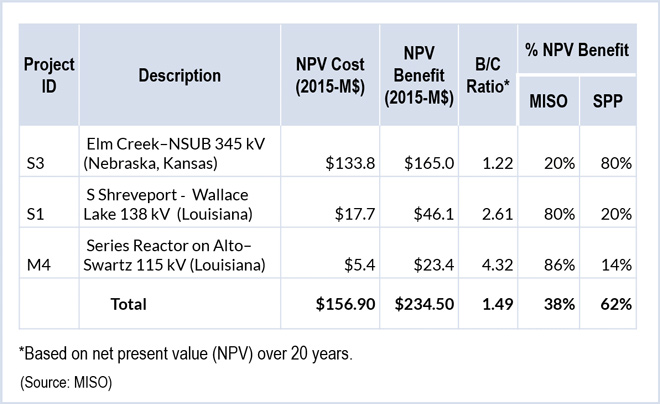By Chris O’Malley
A list of joint transmission projects between MISO and SPP has been trimmed and sent further down the line toward possible board approval late this year.
MISO’s Planning Advisory Committee last week voted to recommend to the MISO-SPP Joint Planning Committee three projects totaling $156.9 million near the RTOs’ seams in Kansas, Nebraska and Louisiana.
MISO and SPP staff initially identified nearly 70 potential economic projects to relieve congested flow gates. In May, the MISO-SPP Interregional Planning Stakeholder Advisory Committee narrowed that list to four transmission projects totaling $276 million. (See SPP, MISO Considering 4 Transmission Projects.)
The list was reduced to three before it was presented at the PAC on June 24. The revision eliminated one of two 345-kV transmission projects proposed to straddle the Kansas-Nebraska border.
Surviving the cut is the proposed $133.8 million, 78-mile Elm Creek-NSUB transmission line. Removed from the list is the $138.8 million, 100-mile Elm Creek-Mark Moore line that would also have run in the north-south direction across the border but would have been further east.
Elm Creek-NSUB had a benefit-cost ratio of 1.22 versus 1.03 for Elm Creek-Mark Moore. Only 7% of the benefits of the latter project would have gone to MISO, compared to 20% from Elm Creek-NSUB.
The three transmission projects would provide an estimated $234.5 million in benefits, based on a net present value analysis over 20 years, according to a report on the MISO-SPP Coordinated System Plan released June 18.
Cost-Benefit Questioned
Though none of the stakeholders at the PAC meeting voted against recommending the three projects, some had questions about how costs would be allocated to MISO. In particular, some questioned how MISO South might be affected by Elm Creek-NSUB.
Eric Thoms, MISO’s manager of planning coordination and strategy, explained that 80% of Market Efficiency Project costs are allocated to zones that benefit, with the remaining 20% spread on a postage stamp basis. “If MISO South is not identified as a [beneficiary], they would not be allocated any of the costs,” he said.
Neal Balu, director of transmission policy at Wisconsin Public Service Corp., and George Dawe, vice president at Duke American Transmission Co., questioned why MISO was pursuing projects that don’t meet the minimum 1.25 ratio benefit-cost ratio required of other MISO projects. “I’m wondering how the 1.22 B-C becomes any different in a MISO analysis than it was in the MISO/SPP joint amount,” Dawe said. “… I think it’s a slippery slope. I think that means you evaluate everything and you never stop.”
Thoms said the projects are being evaluated under the MISO-SPP Joint Operating Agreement, which only requires that “an interregional project has to be greater than $5 million, it has to show benefit to each region of more than 5% and [that] the benefits outweigh the costs.”
He was backed up by Jenell McKay, a senior MISO analyst, who explained that because MISO receives only 20% of the benefit of Elm Creek-NSUB, it would be allocated 20% of the cost, or approximately $30 million.
“When MISO takes the project to our regional review process, assuming we get that far, our percent of the costs will be the denominator in the B-C ratio. … So we’re not going to use the full project cost when we determine our regional B-C ratio,” she said.
Next Steps
The projects next go to the MISO/SPP Joint Planning Committee for a vote, and then return to PAC later this summer for regional review. Potential board approval could come late this year.
The projects are also receiving scrutiny by SPP in a roughly parallel track.


